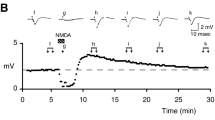Summary
Muscarinic acetylcholine receptors (mAChRs) utilize the direct signaling pathway to ADP-ribosyl cyclase via G proteins within cell membranes to produce cyclic ADP-ribose (cADPR) from ß-NAD+. This signal cascade is analogous to the previously established transduction pathways from mAChRs to adenylyl cyclase and phospholipase Cß. Together with cytosolic Ca2+, cADPR functions to release Ca2+ through ryanodine receptors. This cADPR-dependent and mAChR-controlled increase in cytosolic Ca2+ concentrations may induce various cellular responses.
Access this chapter
Tax calculation will be finalised at checkout
Purchases are for personal use only
Preview
Unable to display preview. Download preview PDF.
Similar content being viewed by others
References
Berridge MJ (1993) A tale of two messengers. Nature 365:388–389
Bomsa MM, Hille B (1989) Protein kinase C is not necessary for peptide-induced suppression of M current or for desensitization of the peptide receptors. Proc. Natl. Acad. Sei. USA 86:2943–2947
Brillantes A-MB, Ondrias K, Scott A, et al (1994) Stabilization of calcium release channel (ryanodine receptor) function by FK506-binding protein. Cell 77:513–523
Brown DA, Higashida H (1988) Inositol 1,4,5-trisphosphate and diacylglycerol mimic bradykinin effects on mouse neuroblastoma x rat glioma hybrid cells. J Physiol 397:185–207
Cervantes-Laurean D, Minter DE, Jacobson EL, et al (1993) Protein glycation by ADP-ribose: studies of model conjugates. Biochemistry 32:1528–1534
Fukuda K, Higashida H, Kubo T, et al (1988) Selective coupling with K+ currents of muscarinic acetylcholine receptor subtypes in NG108–15 cells. Nature 335:355–358
Galione A, White A, Willmott N, et al (1993) cGMP mobilizes intracellular Ca2+ in sea urchin eggs by stimulating cyclic ADP-ribose synthesis. Nature 365:456–459
Gilman AG (1984) G proteins and dual control of adenylate cyclase. Cell 36:577–579
Higashida H (1997) ADP-ribosyl cyclase coupled with receptors via G proteins. FEBS Lett 418:355–356
Higashida H, Brown DA (1986) Two polyphosphatidylinositide metabolites control two K+ currents in a neuronal cell. Nature 323:333–335
Higashida H, Egorova A, Hoshi N, et al (1996) Streptozotocin, an inducer of NAD+ decrease, attenuates M-potassium current inhibition by ATP, bradykinin, angiotensin II, endothelin 1 and acetylcholine in NG108–15 cells. FEBS Lett 379:236–238
Higashida H, Robbins J, Egorova A, et al (1995) Nicotinamide-adenine dinucleotide regulates muscarinic receptor-coupled K+ (M) channels in rodent NG108–15 cells. J Physiol 482:317–323
Higashida H, Yokoyama S, Hashii, M, et al (1997) Muscarinic receptor-mediated dual regulation of ADP-ribosyl cyclase in NG108–15 neuronal cell membranes. J Biol Chem 272:31272–31277
Hua S-Y, Tokimasa T, Takasawa S, et al (1994) Cyclic ADP-ribose modulates Ca2+ release channels for activation by physiological Ca2+ entry in bullfrog sympathetic neurons. Neuron 12:1073–1079
Lam E, Martin MM, Timerman AP, et al (1995) A novel FK506 binding protein can mediate the immunosuppressive effects of FK506 and Is associated with the cardiac ryanodine receptor. J Biol Chem 270:26511–26522
Lee HC (1997) Mechanisms of calcium signaling by cyclic ADP-ribose and NAADP. Physiol. Rev. 77:1133–1164
Noda M, Ishizaka N, Yokoyama S, et al (1996) Inositol trisphosphate/Ca2+ as messengers of bradykinin B2 and muscarinic acetylcholine ml-m4 receptors in neuroblastoma-derived hybrid cells. J Lipid Med Cell Signal 14:175–185
Noguchi N, Takasawa S, Nata K, et al (1997) Cyclic ADP-ribose binds to FK506-binding protein 12.6 to release Ca2+ from islet microsomes. J Biol Chem 272:3133–3136
Ogura A, Myojo Y, Higashida H (1990) Bradykinin-evoked acetylcholine release via inositol trisphosphate-dependent elevation in free calcium in neuroblastoma x glioma hybrid NG108–15 cells. J Biol Chem 265:3577–3584
Selyanko AA, Brown, DA (1996) Intracellular calcium directly inhibits potassium M channels in excised membrane patches from rat sympathetic neurons. Neuron 16:151–162
Prasad GS, McRee DE, Stura EA, et al (1996) Crystal structure of Aplysia ADP ribosyl cyclase, a homologue of the bifunctional ectozyme CD38. Nature Struct Biol 3:957–964
Sitsapesan R, McGarry SJ, Williams AJ (1995) Cyclic ADP-ribose, the ryanodine receptor and Ca2+ release. Trends Pharmacol. Sei. 16:386–389.
Yano K, Higashida H, Inoue R, et al (1984) Bradykinin-induced rapid breakdown of phosphatidylinositol 4,5-bisphosphate in neuroblastoma x glioma hybrid NG108–15 cells. J Biol Chem 259:10201–10207
Author information
Authors and Affiliations
Editor information
Editors and Affiliations
Rights and permissions
Copyright information
© 2000 Springer Japan
About this paper
Cite this paper
Higashida, H., Yokoyama, S., Hashii, M., Taketo, M. (2000). Slow Synaptic Responses in Neuronal Tumor Cells: Dual Regulation of ADP-Ribosyl Cyclase and Inhibition of M-Current by Muscarinic Receptor Stimulation. In: Kuba, K., Higashida, H., Brown, D.A., Yoshioka, T. (eds) Slow Synaptic Responses and Modulation. Springer, Tokyo. https://doi.org/10.1007/978-4-431-66973-9_4
Download citation
DOI: https://doi.org/10.1007/978-4-431-66973-9_4
Publisher Name: Springer, Tokyo
Print ISBN: 978-4-431-66975-3
Online ISBN: 978-4-431-66973-9
eBook Packages: Springer Book Archive




